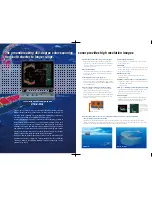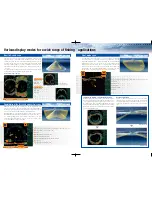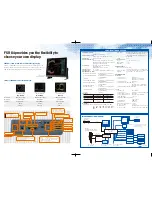
Inset display can be
positioned right or left
Various display modes for a wide range of fishing applications
Full-circle scan can be set at the bearing of horizontally -5 degrees to 90
degrees under the vessel. Additionally, the dual full circle scan modes
simultaneously show two full-circle scans at different tilt angles or range
selected by the operator. The fish school shown on two images from far and
near ranges permit skippers to conduct comparison between the two
different targets. In other words, skippers can actually operate two sonar on
one screen.
To enhance fishing operations, the images are presented in a variety of ways
including dual-portrait, dual-landscape and inset modes.
Adding to full-circle scan, the vertical scan can be displayed to show
directional scan image of the selected bearing. The vertical scan setting can
be simply done by just using the trackball to place the marker at desired
location on the full-circle display, and press the designated key.
By utilizing both scans, the skipper can obtain location of a fish school and
fish distribution in horizontal and vertical perspectives all the same time.
It is extremely helpful to grasp the spread of fish school or the most
concentrated part of the target, as it is not necessary to go over the school
to see the distribution on the echosounder.
Suppressing Bottom and Surface Reflection
In shallow fishing grounds with hard or rocky bottom, bottom
reflections often interfere with wanted fish echoes and they can
not be eliminated sufficiently with gain controls. In such cases,
the output power can be reduced by adjusting the Tx output
instead of turning down the gain. The picture becomes clearer
when output power is reduced rather than when the GAIN is
decreased as illustrated below.
Beam Stabilization
Thanks to FSV-84’s built-in motion sensor, the beam
stabilization mode maintains the sonar beam at required tilt
by compensating for ship's pitching and rolling. This gives an
unwavering presentation of the echo images even in rough
seas.
Dual display (right and left)
Inset display mode
Landscape display mode
Stabilization ON
Stabilization OFF
Horizontal scan 1
Range: 150 m
Tilt:
45
Gain: 5.0
Horizontal scan 2
Range: 300 m
Tilt:
20
Gain: 5.0
Direct distance, horizontal distance, water depth, and bearing to the cursor.
Bearing mark for vertical scan 1 (V1).
Cursor
Range distance of vertical scan
Water depth under the boat
Range, tilt, and display mode of Horizontal scan
Ship track
Range and gain of vertical scan
Direct distance, horizontal distance, water depth, and bearing to the cursor.
Seabed
Fish school
Ship track
Range and tilt
Gain
Horizontal scan 1
Horizontal scan 2
vertical scan 2
vertical scan 1
The Slant mode shows a 180-degree cross section, using chosen tilt angle
and train setting. It is extremely useful for detecting bottom fish and
monitoring changing bottom conditions, identifying the location of trawling
activity. Purse seiners can also use this mode for observations of fish
behavior and school structure in the net so that fish would not move away
from the purse before catching. Moreover, sonar beam can be tilted to 90
degrees under the vessel and rotate 360 degrees, which can show scan
image of the whole sea area around the vessel without any blind spot.
Combination of the full-circle and vertical scans
Dual full-circle scan
Slant mode scan








